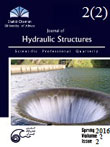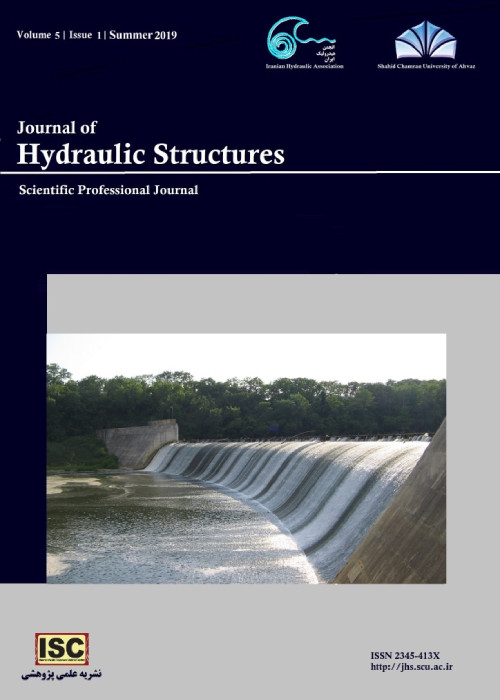فهرست مطالب

Journal of Hydraulic Structures
Volume:2 Issue: 2, Autumn 2016
- تاریخ انتشار: 1396/03/24
- تعداد عناوین: 6
-
-
Pages 1-21In this research, a hybrid wavelet-artificial neural network (WANN) and a geostatistical method were proposed for spatiotemporal prediction of the groundwater level (GWL) for one month ahead. For this purpose, monthly observed time series of GWL were collected from September 2005 to April 2014 in 10 piezometers around Mashhad City in the Northeast of Iran. In temporal forecasting, an artificial neural network (ANN) and a WANN were trained for each piezometer. Kriging was used in spatial estimations. The comparison of the prediction accuracy of these two models illustrated that the WANN was more efficacious in prediction of GWL for one month ahead. Thereafter, in order to predict GWL in desired points in the study area, the kriging method was used and a Gaussian model was selected as the best variogram model. Ultimately, the WANN with coefficient of determination and root mean square error and mean absolute error, 0.836 and 0.335 and 0.273 respectively, in temporal forecasting and Gaussian model with root mean square, 0.253 as the best fitted model on Kriging method for spatial estimating were suitable choices for spatiotemporal GWL forecasting. The obtained map of groundwater level showed that the groundwater level was higher in the areas of plain located in mountainside areas. This fact can show that outcomes are respectively correct.Keywords: Artificial neural network, wavelet, Kriging, spatiotemporal prediction, Groundwater level
-
Numerical investigation of free surface flood wave and solitary wave using incompressible SPH methodPages 22-34Simulation of free surface flow and sudden wave profile are recognized as the most challenging problem in computational hydraulics. Several Eulerian/Lagrangian approaches and models can be implemented for simulating such phenomena in which the smoothed particle hydrodynamics method (SPH) is categorized as a proper candidate. The incompressible SPH (ISPH) method hires a precise incompressible hydrodynamic formulation to calculate the pressure of fluid, and the numerical solution is obtained by using a two-step semi-implicit scheme. This study presents an ISPH method to simulate three free surface problems; (1) a problem of sudden dam-break flood wave on a dry bed with and obstacle in the downstream, (2) a test case of the gradual collapse of the water column on a wet bed and (3) a case of solitary wave propagation problem. The model has been confirmed based on the results of experiments for the dam-break problems (in which was set up by the authors) as well as the collapse of the water column test case and analytical calculations for the solitary wave simulation. The computational results with a mean relative error less than 10%/4% for the wave height/wave front position, demonstrated that the applied ISPH flow model is an appropriate modeling tool in free surface hydrodynamic applications.Keywords: Free-surface flows, Dam-break, Solitary wave, Incompressible smoothed particle hydrodynamics
-
Pages 35-45In order to measure precipitation as the main variable for estimating the runoff and designing hydraulic structures, the satellite algorithm products that have the proper spatial and temporal coverage, can be used. In this study, at first, the daily streamflow simulation of Sarough-Cahy River from the Zarinehroud basin was conducted through the artificial neural network (ANN) and ground data of daily precipitation, temperature and discharge for the years of 1988 to 2008. The developed network was trained, validated and tested. Then, in order to evaluate the products of satellite precipitation algorithms in streamflow simulation which is the aim of this study, daily satellite rainfall data of PERSIANN, TMPA-3B42V7, TMPA-3B42RT and CMORPH between 2003 and 2008 were used as an input data to the trained ANN model. Considering indices of R2, RMSE and MAE implemented for evaluations, the results indicated that satellite rainfall algorithms are able to simulate runoff efficiently over the study area.Keywords: Satellite Precipitation Products (SPPs), Simulation, Daily streamflow, Artificial Neural Networks (ANNs), Basin
-
Pages 46-61Bridges are very important for establishing communication paths. For this reason, it is important to control scour around bridge piers. Several methods have been proposed for scour control. One of the most useful methods is the use of submerged vanes. In the other hand, laboratory circumstances force many considered effective factors to be skipped in the scour phenomenon. In this situation, the importance of using numerical models would appear even more. In this research, numerical simulation of the flow pattern around the piers surrounded by submerged vanes has been carried out. For this purpose, the structure simulated in three dimensions using Fluent software. K-ε turbulence model with VOF and mixture models for multiphase flow simulation were applied. Afterward analysis of the water surface profiles, velocity distribution profiles, and shear tension of the bed in multiple placements conditions including multiple vanes within two flow intensity and two different angles were performed. The results showed that there is a good agreement between numerical and experimental results. The best models in this research were found to be Realizable k-ε turbulence model with VOF multiphase model for water surface profile and velocity distribution profiles. The maximum extracted relative errors for water surface profiles and velocity distribution profiles were 2.23% and 2.92%, respectively. Also, analysis of the counts and placement angles showed that 6 vanes rather to 2 and 4 vanes and also angle of 30 degrees rather to angle of 20 degree performs better in action. The other results of this study, are no change in water surface profiles, reduction of the velocity and the amount of shear stress around the piers in different placement conditions including multiple submerged vanes.Keywords: Scouring, Flow pattern, Bridge pier, Numerical simulation, submerged vanes
-
Pages 62-73Floods are among the natural disasters that cause human hardship and economic loss. Establishing a viable flood forecasting and warning system for communities at risk can mitigate these adverse effects. However, establishing an accurate flood forecasting system is still challenging due to the lack of knowledge about the effective variables in forecasting. The present study has indicated that the use of artificial intelligence, especially neural networks is suitable for flood forecasting systems (FFSs). In this research, mathematical modeling of flood forecasting with the application of Artificial Neural Networks (ANN) and data fusion technique were used in estimating the flood discharge. Sensitivity analysis was performed to investigate the significance of each model input and the best MLP ANN architecture. The data used in developing the model comprise discharge at different time steps, precipitation and antecedent precipitation index for a major river basin. Application of model on a case study (Karun River in Iran) indicated that rainfall-runoff process using data fusion approach produces results with higher degrees of precision.Keywords: Flood Forecasting, neural networks, Data Fusion, Sensitivity analysis, Karun River
-
Pages 74-84Several types of sediment transport equations have been developed for estimation of the river sediment materials during the past decades. The estimated sediment from these equations is very different, especially when they applied for a specific river. Therefore, choice of an equation for estimation of the river sediment load is not an easy task. In this study 10 important sediment transport equations namely; Meyer-Peter and Muller (1948), Einstein (1950), Bagnold (1966), Engelund and Hansen (1972), Toffaleti (1969), Yang (1996), Van Rijn (2004), Wiuff (1985), Samaga et al. (1986) and Beg (1995) are used to estimate sediment load of the Karun River in Iran. The estimated sediment load compared with the measured field data by using statistical criteria such as root mean square error (RMSE), mean absolute error (MAE) and correlation coefficient (R2). Results showed that Engelund and Hansen formula can provide reliable estimates of sediment load of the Karun River which have high suspended sediment load concentration with RMSE of 3725 ton/day, MAE of 1058.82 ton/day and R2 of 0.41. Bagnold and Wiuff formulas estimated the total sediment load 280 % and 700% more than the measured values and the Van Rijn, Tofaleti and Bagnold formulas estimated the sediment load 99 %, 71% and 93 % lower than the measured values, respectively. The comparison indicated that Samaga, Einstein, Tofaleti and Yang equations with low accuracy are not suitable for estimation of sediment load of the Karun River. The main reason for this difference is related to fact that the Karun River carries fine sediment (wash load) which these equations not considered it.Keywords: Sediment, Suspended load, bed load, transport formula, Karun River


